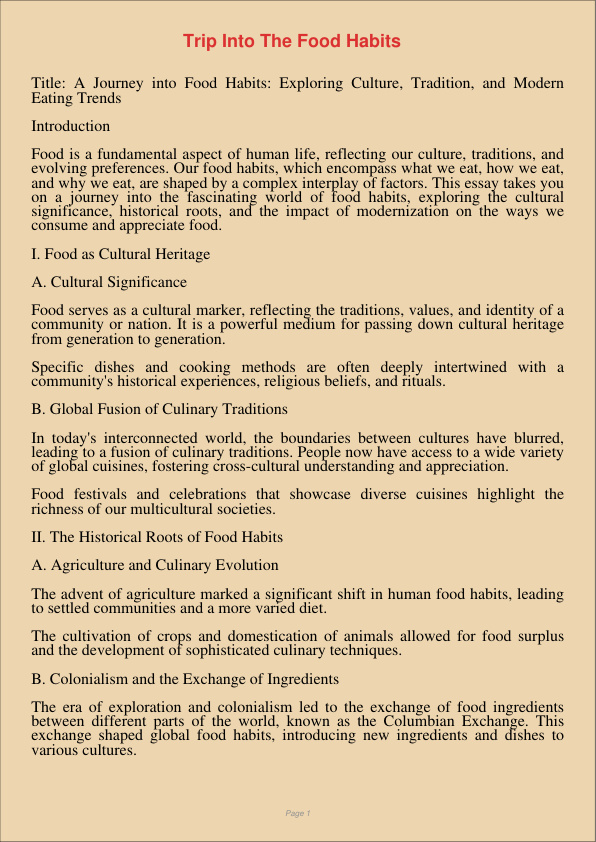Trip Into The Food Habits
Jan 8, 2024
food habits
trip
Education
Business
Title: A Journey into Food Habits: Exploring Culture, Tradition, and Modern Eating Trends
Introduction
Food is a fundamental aspect of human life, reflecting our culture, traditions, and evolving preferences. Our food habits, which encompass what we eat, how we eat, and why we eat, are shaped by a complex interplay of factors. This essay takes you on a journey into the fascinating world of food habits, exploring the cultural significance, historical roots, and the impact of modernization on the ways we consume and appreciate food.
I. Food as Cultural Heritage
A. Cultural Significance
Food serves as a cultural marker, reflecting the traditions, values, and identity of a community or nation. It is a powerful medium for passing down cultural heritage from generation to generation.
Specific dishes and cooking methods are often deeply intertwined with a community’s historical experiences, religious beliefs, and rituals.
B. Global Fusion of Culinary Traditions
In today’s interconnected world, the boundaries between cultures have blurred, leading to a fusion of culinary traditions. People now have access to a wide variety of global cuisines, fostering cross-cultural understanding and appreciation.
Food festivals and celebrations that showcase diverse cuisines highlight the richness of our multicultural societies.
II. The Historical Roots of Food Habits
A. Agriculture and Culinary Evolution
The advent of agriculture marked a significant shift in human food habits, leading to settled communities and a more varied diet.
The cultivation of crops and domestication of animals allowed for food surplus and the development of sophisticated culinary techniques.
B. Colonialism and the Exchange of Ingredients
The era of exploration and colonialism led to the exchange of food ingredients between different parts of the world, known as the Columbian Exchange. This exchange shaped global food habits, introducing new ingredients and dishes to various cultures.
Iconic foods like potatoes, tomatoes, and chili peppers, which are now staples in many cuisines, were introduced to new regions during this period.
III. Modern Eating Trends and Their Impact
A. Fast Food Culture
The fast food culture, marked by convenience, speed, and uniformity, has become a global phenomenon. It reflects the fast-paced nature of modern life but also raises concerns about health and sustainability.
The popularity of fast food chains and their global reach illustrate the impact of globalization on food habits.
B. Healthy Eating and Sustainability
In recent years, there has been a growing emphasis on healthy eating, with people seeking organic, locally sourced, and sustainable food options.
Awareness of the environmental impact of food production has led to a shift towards plant-based diets and sustainable food choices.
IV. The Future of Food Habits
A. Technological Advancements
Advances in technology, such as lab-grown meat and vertical farming, are poised to transform the way we produce and consume food. These innovations hold the potential to address issues like food security and sustainability.
B. Culinary Creativity and Fusion
The future of food habits may see an even greater fusion of culinary traditions as globalization continues to connect diverse cultures.
Innovative chefs and food enthusiasts are likely to experiment with new ingredients and cooking methods, pushing the boundaries of culinary creativity.
Conclusion
Food habits are a dynamic and evolving aspect of human culture. They reflect our traditions, values, and the impact of globalization and modernization on the ways we eat. As we journey through the world of food, we must appreciate the cultural richness and historical significance of our culinary traditions while also considering the impact of contemporary trends on our health and the planet. The future of food habits holds exciting possibilities, where technology and creativity are poised to redefine the way we nourish ourselves and connect with the world.
